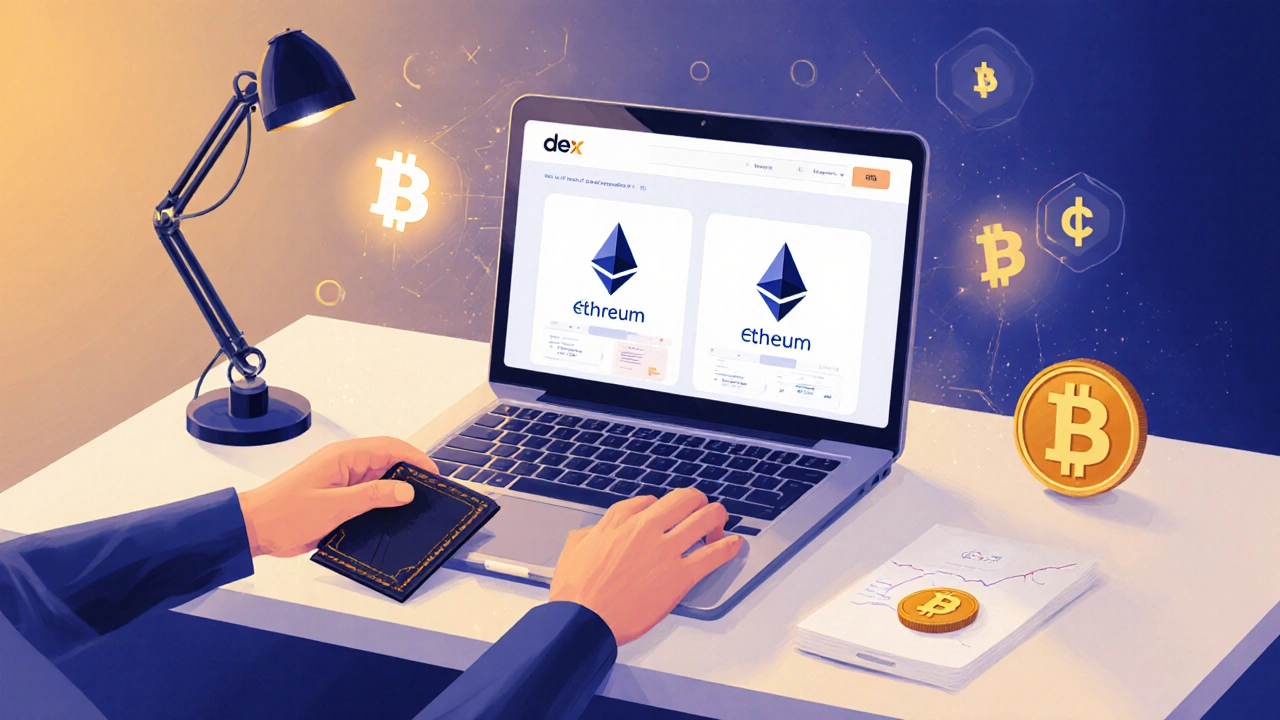Quick Takeaways
- A DEX lets you trade crypto without a central authority.
- Smart contracts automate order matching and asset custody.
- Liquidity pools replace traditional order books on many DEXs.
- Risks include smart‑contract bugs and price‑impact slippage.
- Getting started only requires a compatible wallet and a bit of gas.
What a DEX Actually Is
When you hear the term DEX is a decentralized exchange that lets users trade cryptocurrencies directly from their wallets without a middle‑man, think of it as an online marketplace that lives on the blockchain instead of a company’s servers. Unlike a Centralized Exchange (CEX) that holds your funds and matches orders on its own order book, a DEX runs on smart contracts that execute trades automatically on the underlying blockchain. The moment you click “swap,” the code takes over, moves the tokens, and records the transaction on the public ledger.
How DEXs Work Under the Hood
Two core mechanisms make a DEX functional: the execution layer (smart contracts) and the liquidity source (either an order‑book or a pool).
Smart Contracts: The Trust‑Less Engine
A smart contract is self‑executing code stored on a blockchain that enforces the rules of a transaction without human intervention. When you approve a trade, the contract checks that you have enough of the input token, calculates the output amount, deducts the appropriate gas fee, and updates the balances. Because the contract is immutable, you can’t be tricked by a rogue operator - the rules are set in stone.
Liquidity Pools vs. Order Books
Early DEXs mimicked CEXs by publishing an on‑chain order book, but that approach struggled with latency and thin markets. The breakthrough came with the Automated Market Maker (AMM) model. An Automated Market Maker is a smart contract that determines token prices algorithmically based on the ratio of assets in a liquidity pool. Users who provide assets become liquidity providers (LPs) and earn a share of the trading fees.
In a liquidity pool is a reserve of two tokens locked in a smart contract that enables instant swaps, price changes follow the formula x*y = k (where x and y are token reserves and k is constant). This design removes the need for counterparties and ensures that any size trade can be executed instantly, albeit with some price slippage.

Key Benefits That Keep Users Coming Back
- Custody control: Your assets stay in your wallet until the instant the contract swaps them.
- Permissionless access: No KYC, no email, just a crypto address.
- Global liquidity: Anyone can add funds to a pool, creating a shared market for the whole world.
- Programmable incentives: Yield farming, liquidity mining, and token‑based rewards boost participation.
Risks & How to Navigate Them
Freedom comes with responsibility. Here are the most common pitfalls and how to protect yourself.
- Smart‑contract bugs: Code is immutable; a single flaw can drain a pool. Stick to contracts that have been audited by reputable firms (e.g., ConsenSys Diligence, OpenZeppelin).
- Impermanent loss: When the price of one token in a pool moves dramatically, LPs can end up with less value than simply holding the tokens. Use calculators to estimate loss before adding liquidity.
- Slippage and price impact: Large swaps shift the pool’s ratio, costing more than expected. Most interfaces let you set a slippage tolerance; keep it low for stable‑coin pairs.
- Gas spikes: On congested networks like Ethereum , fees can surge to $50 or more, eroding small‑trade profits. Consider layer‑2 solutions (Polygon, Arbitrum) or alternative chains (BSC, Solana).
Popular DEX Examples to Explore
Below are three of the most widely used decentralized exchanges, each illustrating a different design choice.
- Uniswap (Ethereum): The poster child for AMM. Uses a 0.3% fee and a simple UI. Supports thousands of ERC‑20 tokens.
- SushiSwap (Multi‑chain): Forked from Uniswap, adds yield farming incentives and cross‑chain bridges.
- PancakeSwap (Binance Smart Chain): Offers lower gas costs, a lottery, and NFT marketplace, all built on BSC’s faster block times.

DEX vs. CEX: Quick Comparison
| Feature | DEX | CEX |
|---|---|---|
| Custody | User retains private keys | Exchange holds funds |
| KYC/AML | Usually none | Required for most services |
| Liquidity source | Liquidity pools or on‑chain order books | Central order book and market makers |
| Trading speed | Depends on blockchain finality (seconds‑minutes) | Near‑instant, off‑chain matching |
| Fees | Gas + protocol fee (0.05‑0.3%) | Maker/taker fees, withdrawal fees |
| Security model | Smart‑contract risk, user‑controlled keys | Exchange‑level security, risk of hacks |
Getting Started: Your First DEX Trade
Ready to try a swap? Follow these five steps.
- Set up a non‑custodial wallet. MetaMask, Trust Wallet, or Coinbase Wallet work on most browsers and mobile devices.
- Add some cryptocurrency. You’ll need a base token-usually ETH on Ethereum, BNB on BSC, or MATIC on Polygon.
- Connect to a DEX. Open the DEX’s website, click “Connect Wallet,” and approve the connection.
- Choose the pair. Select the token you want to sell and the token you want to receive. The interface will show the estimated amount, price impact, and slippage tolerance.
- Confirm and pay gas. Review the transaction, confirm in your wallet, and wait for the blockchain to confirm. Your new token appears in your wallet instantly.
That’s it-no account creation, no email verification, just a few clicks and a transaction hash you can look up on a block explorer.
Frequently Asked Questions
Is a DEX safe to use?
Safety depends on three factors: the smart‑contract code, the network’s congestion (gas fees), and user practices. Stick to well‑audited contracts, keep only the amount you plan to trade in your wallet, and verify URLs to avoid phishing sites.
Do I need to pay taxes when I trade on a DEX?
Tax obligations are the same as on any exchange: every sale, swap, or conversion that results in a gain or loss is a taxable event in most jurisdictions. Keep records of transaction hashes, timestamps, and prices.
Can I earn passive income on a DEX?
Yes. By providing liquidity to a pool you earn a share of the trading fees. Some platforms also offer additional rewards in the form of native governance tokens.
What is ‘impermanent loss’ and how does it affect me?
Impermanent loss occurs when the price ratio of the two tokens in a pool diverges from the ratio at the time you deposited. The more the price moves, the larger the loss relative to simply holding the tokens. It’s “impermanent” because you can recover it if the price returns to the original ratio, but it can become permanent if you withdraw early.
Which blockchain should I use for the lowest fees?
Layer‑2 solutions on Ethereum (Arbitrum, Optimism) and sidechains like Polygon typically offer the cheapest gas. Binance Smart Chain and Avalanche also provide low fees, but consider the trade‑off in security and centralization.


